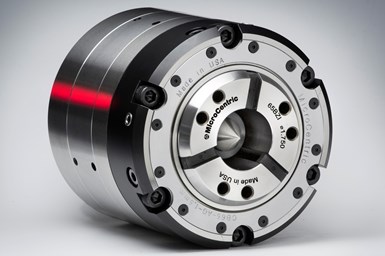Microcentric's Alloy Collet Chuck is a Low-Maintenance Machining Option
Appears in Print as: 'Alloy Collet Chuck is a Low-Maintenance Machining Option'
The collet chuck features a pullback design with a floating collet seat and incorporates a mounting in the ID of the chuck body for centers or other types of locators. The floating collet seat design, with the vulcanized quick-change collets, enables the collet to compensate up to 1.5 mm.
Edited by

Microcentric’s quick change compensating collet chuck is suited for applications where shafts are machined between centers. It features a pullback design with a floating collet seat and incorporates a mounting in the ID of the chuck body for centers or other types of locators. The floating collet seat design, with the vulcanized quick-change collets, enables the collet to compensate up to 1.5 mm.
The floating collet seat is sealed and the chuck is lubricated for life, reducing maintenance requirements. The chuck’s compact OD and short overall length compared with conventional compensating chucks provides greater rigidity and tool clearance, Microcentric says.
All components are made from hardened, precision-ground alloy steel. The chuck generates a maximum clamping force of 84 kN (18,884 lbs) and is rated for spindle speeds up to 6,000 rpm.
RELATED CONTENT
-
Collets Vs. Chucks
Find the definition, types and advantages of both CNC collets and chucks for workholding as well as the best applications for each, in this article.
-
Calculating Surface Footage and RPM for Optimum Tool Life
Tech Brief: Calculating Surface Footage and RPM for Optimum Tool Life
-
A Guide to Insert Coating Processes and Materials
Few materials have had a greater impact on our economy and industrialized culture than cemented tungsten carbide.


